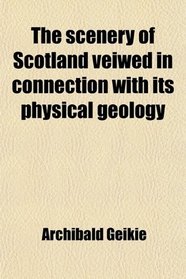Search -
The scenery of Scotland veiwed in connection with its physical geology
The scenery of Scotland veiwed in connection with its physical geology
Author:
Purchase of this book includes free trial access to www.million-books.com where you can read more than a million books for free. This is an OCR edition with typos. Excerpt from book: CHAPTER II Nature's Sculpture-tools—Air, Rain, Rivers, Springs, Frost The process by which the scenery of a country is produced may be compared to sculptu... more »
Author:
Purchase of this book includes free trial access to www.million-books.com where you can read more than a million books for free. This is an OCR edition with typos. Excerpt from book: CHAPTER II Nature's Sculpture-tools—Air, Rain, Rivers, Springs, Frost The process by which the scenery of a country is produced may be compared to sculptu... more »
ISBN-13: 9780217134057
ISBN-10: 021713405X
Publication Date: 8/8/2009
Pages: 450
Rating: ?
ISBN-10: 021713405X
Publication Date: 8/8/2009
Pages: 450
Rating: ?
0 stars, based on 0 rating




